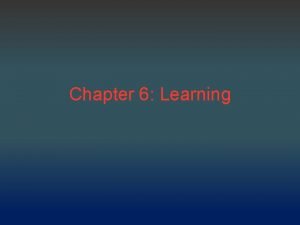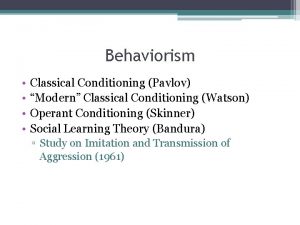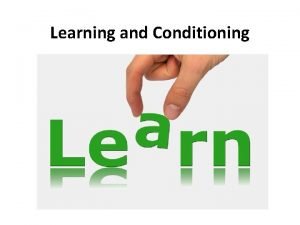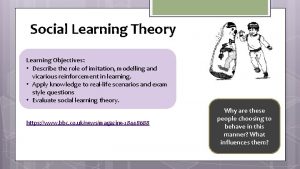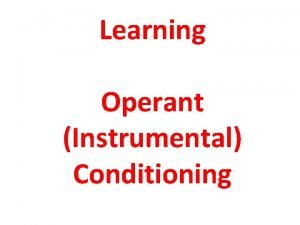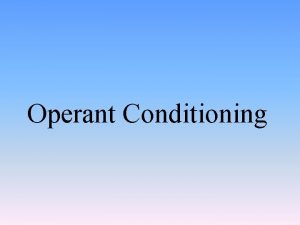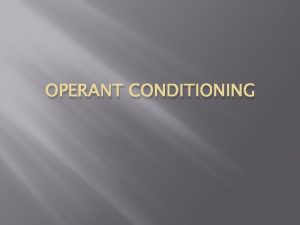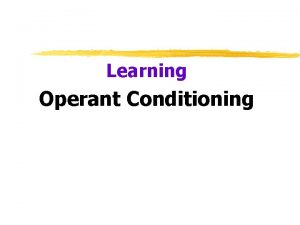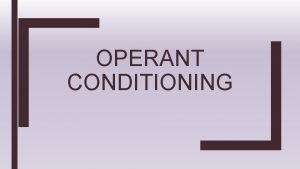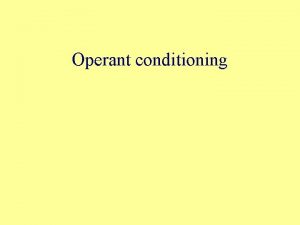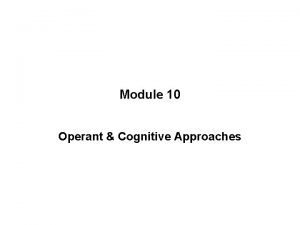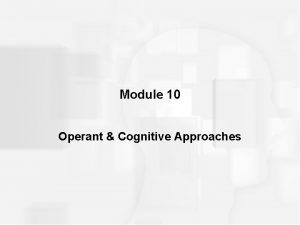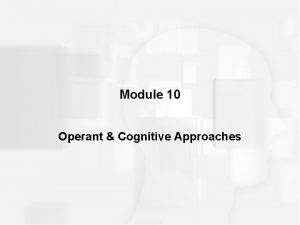Operant Conditioning Chapter 9 Section 2 Operant Conditioning












- Slides: 12

Operant Conditioning Chapter 9: Section 2

Operant Conditioning • Learning in which a certain action is reinforced or punished, resulting in corresponding increases or decreases in occurrence • “Operant” is used because the subject operates on (causes) some change in the environment. • They choose to repeat or eliminate their own behavior.

B. F. Skinner v Trained hungry rats to respond in Skinner Box v Had to learn how to get the food to appear in a cup v The answer was to press a bar down. v When they got closer to the bar, a piece of food dropped.

Reinforcement • A stimulus or event that follows a response and increases the likelihood that the response will be repeated • I. e. Social acceptance, money, extra privileges • Positive Reinforcement- something is added after an action • Negative Reinforcement- something unpleasant is taken away after an action

• Primary reinforcer- stimulus that is naturally rewarding, such as food or water • Secondary reinforcer- stimulus such as money, that becomes rewarding through its link with a primary reinforcer

Schedules Of Reinforcement 1. Fixed-Ratio Schedule- a pattern of reinforcement in which a specific number of correct responses is required before reinforcement can be obtained – A dentist making the same amount of money for every cavity filled 2. Variable-Ratio Schedule- a pattern of reinforcement in which an unpredictable number of responses are required before reinforcement can be obtained – I. e. A person working on commission

3. Fixed-Interval Schedule- a pattern of reinforcement in which a specific amount of time must elapse before a response will elicit reinforcement – I. e. Cramming for an exam 4. Variable-Interval Schedule- a pattern of reinforcement in which changing amounts of time must elapse before a response will obtain reinforcement – I. e. Surprise pop quizzes in class

Shaping • Technique in which the desired behavior is “molded” by first rewarding any act similar to that behavior and then requiring ever-closer approximations to the desired behavior before giving the reward • Sculpting new responses out of old ones

Chaining • Response chain- learned reactions that follow one another in sequence, each reaction producing the signal for the next • I. e. Swimming requires learning how to breathe, move arms, and kick.

Aversive Control • Process of influencing behavior by means of unpleasant stimuli • Negative Reinforcement – Escape Conditioning- training to remove an unpleasant stimulus – Avoidance Conditioning- training to respond so as to prevent the occurrence of an unpleasant stimulus

• Punishment- stimuli the causes behavior to decrease – Disadvantages Of Punishment • Can produce unwanted side effects (rage, fear, etc. ) • Avoidance of the punisher • Just eliminate behavior, not add positive behavior

 Operant conditioning vs classical conditioning
Operant conditioning vs classical conditioning Little albert classical conditioning
Little albert classical conditioning Deborah skinner
Deborah skinner Operant vs classical conditioning
Operant vs classical conditioning Classical conditioning v. operant conditioning
Classical conditioning v. operant conditioning Operant vs. classical conditioning
Operant vs. classical conditioning Secondary reinforcers
Secondary reinforcers Difference between classical and operant conditioning
Difference between classical and operant conditioning Classical conditioning vs operant conditioning
Classical conditioning vs operant conditioning Operant conditioning classical conditioning
Operant conditioning classical conditioning Home youtube
Home youtube Assumptions of social learning theory
Assumptions of social learning theory Skinner experiment
Skinner experiment







